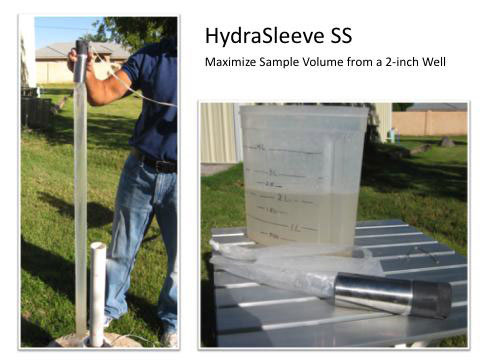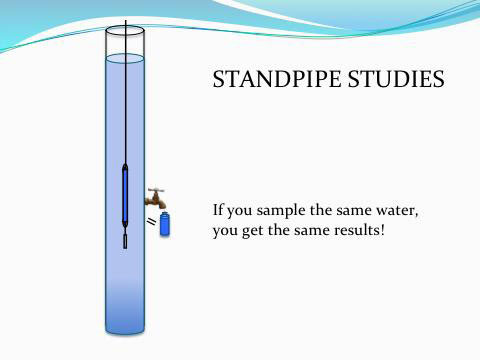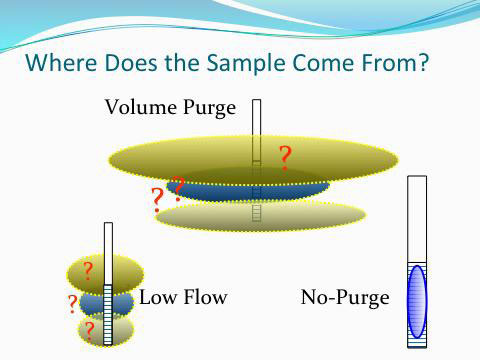The use of no-purge samplers, like the HydraSleeve, is arguably the fastest growing segment of the groundwater monitoring market. Tens of thousands of samples are collected each year using no-purge sampling devices. Why? It provides formation quality samples using a much simplified and repeatable groundwater sampling method, resulting in dramatically reduced field time and expense. In addition, it is a less energy intensive method of collecting groundwater samples, producing a smaller carbon footprint than conventional sampling methods.
The following constitute the top three questions we get pertaining to the HydraSleeve.
1) HOW DO I SOLVE PROBLEMS WITH SAMPLE VOLUME USING A NO-PURGE SAMPLER? HOW DO I GET MORE VOLUME FROM MY NO-PURGE SAMPLER?
By definition, no-purge sampling devices are restricted to collecting the volume of fluid contained within the well screen. For example, a 2-inch well with a 10-foot long saturated screen has an absolute maximum of 6.4 liters (1.6 gallons) of water available for no-purge sampling.
In response to the sample volume issue, GeoInsight has developed a sampler which will collect the most water available from a 2-inch (schedule 40) well. This new device, developed in the summer of 2009, the HydraSleeve Super/SkinnySleeve (SS), has almost doubled the amount of water that could be collected out of a 2-inch well as compared with earlier designs of the HydraSleeve. Prior to the development of the HydraSleeve SS, only about 45% of the available water could be captured from the well screen. Using the HydraSleeve SS, up to 80% of the available water in the well screen can be collected as sample. This is very important for 2-inch wells with a short screened interval or a short water column within the screen.
2) WHAT DO THE REGULATORS THINK?
When we first introduced the HydraSleeve, this was the most asked question. Now most regulators are familiar with no-purge sampling.
HydraSleeve and Passive Diffusion Bags have been used in all 50 states, Canada and overseas. There are a few states that may recommend either well-volume purging or low-flow methods in their guidance, but they still do not exclude no-purge sampling. There are no states that specifically prohibit the use of any no-purge (passive) sampling technology.
The regulatory approval climate is changing. The Kansas Department of Health and Environment (KDHE) has developed a "Sampling and Analysis Plan Development for Industrial Landfills "technical guidance document", which discusses the proper use of the HydraSleeve no-purge sampler.
Conversion to no-purge sampling methods is typically examined on a site-by-site basis. Usually this entails an initial round of no-purge sampling, the results of which are compared with the results from the site's previous sampling method. The comparison of data from the two methods is used to determine if no-purge sampling meets the site's data quality objectives.
HydraSleeve simplicity and low cost enables the user to conduct a comparison study easily, inexpensively and efficiently. Using our newest HydraSleeve, the SpeedBag will allow the most cost effective
3) WHY DON'T MY RESULTS COMPARE IN ALL THE WELLS?
In the majority of wells, results from samples collected with the HydraSleeve (as well as other no-purge samplers) will compare favorably with results from samples collected with traditional sampling methods (i.e. well-volume purging and low-flow purging). Some samples may have slightly higher concentrations and some slightly lower concentrations. However, in a few wells, some samples may not compare very well at all. In almost all of these cases, this is due to the inherent differences between low-flow sampling, well-volume purging and no-purge sampling and the resulting source of the sampled water.
Standpipe studies conducted by Parker and others in 2002 demonstrated that no-purge samplers (HydraSleeve included) produced statistically similar results in a spiked standpipe when compared to results from samples collected from a discharge spigot at the same depth. Similar investigations done at the Stennis Space Center under the EPA Environmental Technology Verification Program compared low-flow pumping systems and no-purge sampling devices to control samples collected in a 100-foot long standpipe. Again, the results compared favorably with the control samples.
In short, if you sample the same water you get the same results.


MORE ON COMPARING ANALYTICAL RESULTS
====================================================================================================================================
